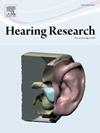响度不适水平在延长的高频在年轻人:一个潜在的标志听觉亢进。
IF 2.5
2区 医学
Q1 AUDIOLOGY & SPEECH-LANGUAGE PATHOLOGY
引用次数: 0
摘要
响度不适水平(ldl)通常仅在标准频率(0.25-8 kHz)下测量,这可能会限制其在评估响度障碍(如听觉亢进)时的诊断效用。本研究的目的是:(1)在非耳聋人群中建立扩展高频(EHFs, 9-16 kHz)的规范LDL,(2)检查与参与者听力学和人口统计学特征的关联,以及(3)在一小群自我报告的耳聋参与者中探索EHFs LDL。我们招募了103名参与者(52名女性,50名男性,1名非二元),平均年龄27.5岁,分为非听觉亢进组(n = 94)和听觉亢进组(n = 9)。在0.25 ~ 16 kHz测量纯音听力阈值(HTs),在0.5、4、9、11.2、12.5、14和16 kHz评估ldl。在非耳聋参与者中,EHF ldl平均为74 dB HL (SD = 9.1-16.8;范围= 10-100)。ldl与医院焦虑抑郁量表的噪音敏感量表(NSS)、焦虑子量表(HQ)和焦虑子量表呈中小负相关,与年龄和焦虑无显著相关。听力亢进的参与者EHF平均HTs明显变差,ldl降低,整个频率范围的动态范围减小。本研究首次报道了EHF患者的低密度脂蛋白水平,为听力学家提供了有价值的参考。这些发现表明,EHF措施可以提高响度相关疾病(如听觉亢进)的诊断,支持早期识别和量身定制的干预措施。需要进一步的研究来充分评估EHF LDL评估的临床价值。本文章由计算机程序翻译,如有差异,请以英文原文为准。
Loudness discomfort levels at extended high frequencies in young adults: A potential marker of hyperacusis
Loudness discomfort levels (LDLs) are typically measured only at standard frequencies (0.25–8 kHz), which may limit their diagnostic utility in assessing loudness disorders such as hyperacusis. The aim of this study was to (1) establish normative LDL for extended high frequencies (EHFs, 9–16 kHz) in a non-hyperacusis population, (2) examine associations with participant audiological and demographic characteristics, and (3) explore EHFs LDLs in a small group of self-reported hyperacusis participants. We recruited 103 participants (52 female, 50 male, 1 non-binary) with a mean age of 27.5 years, divided into a non-hyperacusis group (n = 94) and a hyperacusis group (n = 9). Pure tone hearing thresholds (HTs) were measured from 0.25 to 16 kHz and LDLs were assessed at 0.5, 4, 9, 11.2, 12.5, 14 and 16 kHz. In non-hyperacusis participants, average EHF LDLs were of 74 dB HL (SD = 9.1–16.8; range = 10–100). LDLs showed small to medium negative correlations with the Hyperacusis Questionnaire (HQ), the Noise Sensitivity Scale (NSS) and the depression subscale of the Hospital Anxiety and Depression Scale, but no significant correlations with age or anxiety. Hyperacusis participants had significantly worse EHF average HTs, lower LDLs and reduced dynamic ranges across frequency ranges. This study provides the first report of LDLs for EHF in a large cohort and is a valuable reference for audiologists. These findings suggest that EHF measures could improve the diagnosis of loudness related disorders such as hyperacusis, supporting early identification and tailored interventions. Further research is needed to fully assess the clinical value of EHF LDL assessments.
求助全文
通过发布文献求助,成功后即可免费获取论文全文。
去求助
来源期刊

Hearing Research
医学-耳鼻喉科学
CiteScore
5.30
自引率
14.30%
发文量
163
审稿时长
75 days
期刊介绍:
The aim of the journal is to provide a forum for papers concerned with basic peripheral and central auditory mechanisms. Emphasis is on experimental and clinical studies, but theoretical and methodological papers will also be considered. The journal publishes original research papers, review and mini- review articles, rapid communications, method/protocol and perspective articles.
Papers submitted should deal with auditory anatomy, physiology, psychophysics, imaging, modeling and behavioural studies in animals and humans, as well as hearing aids and cochlear implants. Papers dealing with the vestibular system are also considered for publication. Papers on comparative aspects of hearing and on effects of drugs and environmental contaminants on hearing function will also be considered. Clinical papers will be accepted when they contribute to the understanding of normal and pathological hearing functions.
 求助内容:
求助内容: 应助结果提醒方式:
应助结果提醒方式:


